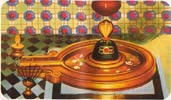-: Hindu Temples :-
| Mahakaleswar | Bhimashankara | Kedarnath |
| Somnath | Mallikarjuna | Omkaresswar |
| Nagneswar | Trayembakeswar | Rameshwaram |
| Vaidyanath Jyotirlinga | Kashi Vishwanath | Grishneswar |
Kashi Vishwanath
12 Jyotirlingam of Lord Shankar
 |
Kashi Vishwanath temple is one of the most
famous Hindu temples dedicated to Lord Shiva and is in the holy city of
Varanasi, India. The temple stands on the western bank of Hinduism's holiest
river Ganges, and the deity is one of the twelve Jyotirlingas the holiest of
Shiva deities. The main deity is known by the name Vishwanatha or
Vishweshwara meaning the Ruler of the universe. The temple town that claims
to be the oldest living city in the world, with 3500 years of documented
history is also called Kashi and hence the temple is popularly called as
Kashi Vishwanath Temple. Due to this 15.5m high golden spire, the temple is
sometimes called as the Golden Temple, similar to the Sikh Gurudwara at
Amritsar.
The temple has been in Hindu mythology for a very long time and a central
part of worship in the Shaiva philosophy. The original temple has not yet
been found and due to invasions, the temple has been destroyed and rebuit a
number of times. The current structure is believed to have been built by
Maharani Ahilya Bai Holkar of Indore in 1780. Since 1983, the temple is
being managed by Govt. of Uttar Pradesh. During the religious occasion of
Shivratri, Kashi Naresh is the chief officiating priest and no other person
or priest is allowed to enter the sanctum sanctorum. It is only after he
performs his religious functions that others are allowed to enter.
Name: Kashi Vishwanath Mandir.
Creator: Maharani Ahilya Bai Holkar
Date built: 1780
Primary deity: Vishwanath (Shiva)
Architecture: Mandir
Location: Varanasi
Website :
http://www.shrikashivishwanath.org/
History of Temple
The Shiva temple is believed to have been there in the site for thousands of
years, as mentioned in old scriptures. The Mughal emperor Akbar allowed the
temple to be constructed but his great-grandson, the Islamic ruler Aurangzeb
ordered its demolition in 1669 and constructed Gaynvapi Mosque, which still
exists alongside the temple.
This mosque has minarets towering 71 metres above the Ganges River and the
traces of the old temple can be seen behind the mosque. The temple spire and
the dome are plated with 1000 kg of gold donated by the mighty Maharaja
Ranjit Singh of Punjab, in 1835.
The Temple Structure
The well in the templeThe temple complex consists of a series of smaller
shrines, located in a small lane called the Vishwanatha Galli, near the
river. The linga the main deity at the shrine is 60 cm tall and 90 cm in
circumference housed in a silver altar. There are small temples for kal
BHAIRO, Dhandapani, Avimukteshwara, Vishnu, Vinayaka, Sanishwara, Virupaksha
and Virupaksh Gauri in the complex. There is a small well in the temple
called the Jnana Vapi (the wisdom well) and it is believed that the
Jytorlinga was hidden in the well to protect it at the time of invasion. It
is said that the main deity of the temple had jumped in the well with the
Shiv Ling in order to protect the (Jyoti-r)Ling from the invaders.
Importance of the Temple
The temple is widely recognized as one of the most important places of
worship in Hindu religion and most of the leading Hindu saints, including
Adi Sankaracharya, Ramakrishna Paramhansa, Swami Vivekananda, Goswami
Tulsidas, Swami Dayananda Saraswati, Gurunanak have visited this site [5]. A
visit to the temple and a bath in the river Ganga is believed to lead one on
a path to Moksha (liberation). Thus, people from all over the nation, try to
visit the place at least once in their lifetime. There is also a tradition
that one should give up at least one desire after a pilgrimage the temple,
and the pilgrimage would also include a visit to the temple at Rameswaram in
South India, where people take the water samples of Ganga to perform prayer
at the temple and bring back the sand from near that temple. Due to the
immense popularity and holiness of this temple, hundreds of temples across
the nation have been built with the same style and architecture.
|










